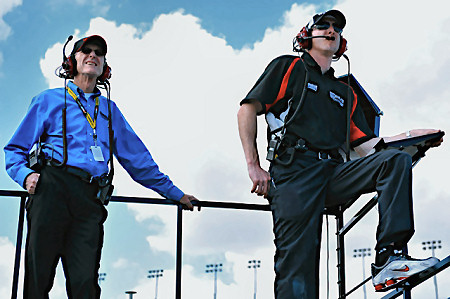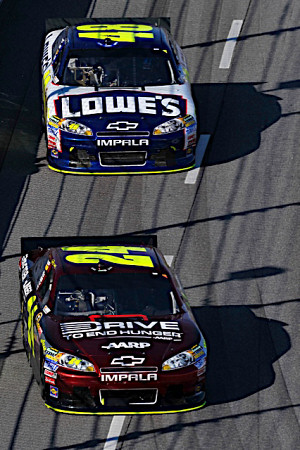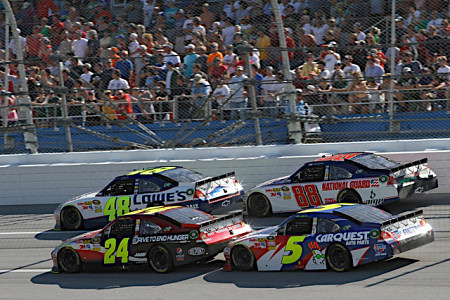The Way It Is/ What it takes to succeed in NASCARby Gordon Kirby |
 It's a fact that Hendrick Motorsports is the leading force in NASCAR today. Over the last seventeen years Rick Hendrick's team has won ten championships and 160 Cup races, establishing itself in a class of its own. The only other teams to win NASCAR's top championship over the same period of time are Joe Gibbs, Roush Fenway and Robert Yates. Gibbs's team won three championships in 2000, '02 and '05, Roush Fenway took a pair of back to back titles in 2003 and '04, and Yates won in '99.
It's a fact that Hendrick Motorsports is the leading force in NASCAR today. Over the last seventeen years Rick Hendrick's team has won ten championships and 160 Cup races, establishing itself in a class of its own. The only other teams to win NASCAR's top championship over the same period of time are Joe Gibbs, Roush Fenway and Robert Yates. Gibbs's team won three championships in 2000, '02 and '05, Roush Fenway took a pair of back to back titles in 2003 and '04, and Yates won in '99.
For the last ten years Hendrick has run four Chevrolets. In recent years the drivers have been Jeff Gordon, Jimmie Johnson, Dale Earnhardt Jr., and Mark Martin. Gordon and Johnson share a total of nine championships and 140 race wins and are NASCAR's most successful active drivers. Gordon, Johnson and Earnhardt qualified for this year's 'Chase for the Cup' and Gordon in particular and Johnson too have shown the capability this year to win another championship for the team. In addition to supplying its mutli-car team Hendrick's operation builds cars and engines for Tony Stewart's two-car Stewart-Haas team. The company also provides engines to James Finch's Phoenix Racing entry and to Dale Jr.'s JR Motorsports Nationwide team. Hendrick employs around 450 people and as many as 500 during the busiest car-building periods. As many as eighty engineers are on the payroll and just over 100 people work in the engine shop. Around 200 Hendrick engines are in circulation this year.  © Nigel Kinrade/Autostock It's well-known that Hendrick operates its four Cup cars out of two race shops. One houses Johnson's #48 with Chad Knaus as crew chief and Earnhardt's #88 with Steve Letarte in charge. The other shop runs Gordon's #24 with crew chief Lance McGrew and Martin's #5 led by Alan Gustafson. For half a dozen years Gordon and Johnson's cars shared one shop but at the beginning of last year Rick Hendrick decided to shake things up and move around his combinations. As well as separating Gordon and Johnson's cars Hendrick moved Steve Letarte from Gordon's team to Earnhardt's while Lance McCrew went from Earnhardt's car to become Gordon's crew chief. Ken Howes is Hendrick's vice president of competition. Howes goes to all the races, basing himself at Gordon's transporter. "The changes have been good," Howes says. "Change is always good. Jeff and Steve Letarte had their time together and we needed to change things around. I think it's done Dale good. It fits his personality and so far it's worked out well." Howes is a South African who came to America in 1984 with Sarel van der Merwe and they won the Daytona 24 Hours with a Porsche-powered March GTP car. Howes went on to run the Corvette GTP program for a few years. The Corvette was run for Chevrolet by Rick Hendrick who was beginning to seriously develop and expand his NASCAR team at the time. Howes thus found himself as a key man in Hendrick's burgeoning operation. It's easy to underestimate NASCAR and oval racing in general but, as noted in recent weeks in this space, its difficult to argue against the fact that NASCAR enjoys the deepest field in motor racing. "You're trying to be faster than a lot of other people, 42 in our case," Howes says. "It's very competitive. The level of difficulty is always hard to gauge other than we live this and, to us, it's extremely difficult. We have a lot of bright people working really hard, just like every other team.  © Nigel Kinrade/Autostock "Another thing people might not appreciate is the tracks vary considerably from longer to shorter to high-banked and flat tracks. They're all different and take a completely different set-up and there are a couple of road races thrown in there as well. Every track is different and unique in its own way." Howes points out that NASCAR's tight rules have ushered in an age of specialization. "The rules obviously are very restrictive," Howes observes. "Most series these days, even Formula One, have a lot of rules. It's not an open formula like it used to be thirty or forty years ago. And what that does is it drives the level of detail. Everything is in the detail. "We now have specialists for everything you can think of. We don't have too many general all-around people anymore. Everybody's focused on their particular area of the car, whether it's a simulation program with the shock absorbers and springs, the devil just gets deeper and deeper in the details. "Probably close to ninety percent of what you look at it in these cars is specifically defined by the rulebook. So there's a very small area left for the engineers to work in and try and be better than everybody else." NASCAR cars may be comparatively under-tired, over-powered, light on downforce and antique in general, but those are the things that make them difficult to drive. "The cars are powerful," Howes notes. "They make mid-800 horsepower. That's where you need to be. And the cars are pretty heavy of course. It weighs 3,500 pounds and runs on pretty narrow tires with limited aerodynamic downforce. But we squeeze every little piece that we can out of it given the rules that we have. "We spend a lot of time in the wind tunnel. We're always searching. Because of all of that and because of the limited grip the cars have they are very sensitive to set-up, very sensitive to track temperature and to sun and cloud." As we all know, strategy and tactics play a big role in NASCAR. "The races are fairly long races and because there are yellow flags and the way caution periods work by the end of the race your head is pretty sore," Howes remarks. "You work hard trying to make the right calls.  © Nigel Kinrade/Autostock New cars are built every year to replace those discarded through accumulated accident damage, but car-building is a never-ending operation. "We need about twelve to fourteen cars dedicated to each driver each year," Howes says. "Obviously you see a fair amount of damage and depending on the level of damage we will repair the cars. But you get to the point where it's not cost-effective and you'll just scrap it. They don't take too long to build. They're fairly straightforward. "You've got to have back-up cars, you've got to have spares in the truck because things can go wrong. So there are a lot of hours and a lot of hard-working people. We build our own chassis and bodies. We build chassis for Stewart-Haas and we build the chassis for JR Motorsports. It's a busy place." Though not obvious to the naked eye new pieces and changes appear constantly. "The pace of development is extremely fast," Howes reports. "The bigger teams spend a fair amount of time in the wind tunnel and, as we always say, you're stacking pennies. "Engine development is ongoing. Those guys amaze me. They make so much progress from year to year. It's mind-boggling. Everybody pushes the power of these engines with the rpm that we run them to and the carburetors we've run for many years. "There are different engines of course. Restrictor plate engines for the big tracks. Short track engines have different camshafts and the mile and half tracks are all different." Coping with the intra-team rivalries, particularly with four cars, is another ongoing battle. "I wouldn't say it's unique," Howes says. "Other teams deal with it too. In the week, everybody's cooperating and the information is out there. There's a lot of cooperation. But when we come to the track the teams are competing against each other. We have to manage that and we do our best. The teams have a fair amount of leeway about how they set the cars up however they think is best. They're given some level of independence. "They'll go at each other then on Monday go back to the shop and be brothers again. It's a difficult thing, a fine line. Obviously the guys are smart enough to realize that the goal is to see a Hendrick car winning and the goal one day is to finish one, two, three, four. If you ask me, I have no concern what that order would be, other than that would be a huge accomplishment for the company. But I'm sure each driver and team would have a preference for where they finished!" Next year brings new noses with more brand identification, plus the arrival of fuel injection. "We'll just update and reskin the cars we have," Howes comments. "We'll build a few new cars but most of them get a lot of work, race to race. There's always some level of damage and the tolerances we have to keep the bodies to these days is unbelievable. Most of the cars will go back for some sort of bodywork after each race. "There are some things to be worked out on fuel injection, programming the ECUs and so on. But it will all be done. There's some smart folks working on it." Kasey Kahne will replace Mark Martin next year. At Hendrick the talented Kahne is expected to develop into a championship contender. "We have to get ready for Kasey Kahne. Kenny Francis is coming with him. So it will be an interesting winter getting Kenny integrated, showing him what we've got and how we operate. Obviously he's going to bring a lot of knowledge with him. So it will be an interesting time." Howes believes every form of racing essentially is the same and has great respect for anyone who succeeds in any form of motor sport across America and around the world. "It doesn't really matter where you go I think it's true of any form of racing," he observes. "If you go and compete against some guys on a short track somewhere on a Saturay night, you better be ready because those guys are awfully good at what they do. They may not have a lot of people but they have the knowledge of their particular series and how it works and how the cars work. The same is true if you go go-kart racing. You better be ready because those guys know their stuff. "Again, it's like other forms of racing. We're competing and you're ego drives you. In our case, I would say we're running scared. We're expected to succeed and we expect what we're doing to succeed." *Next Saturday afternoon, October 8th, it will be my pleasure to speak at the International Motor Racing Research Center's celebration of the 50th anniversary of the first United States Grand Prix at Wakins Glen in 1961. I will talk about 1978 World Champion Mario Andretti and Ferrari expert Michael Lynch will speak about '61 World Champion Phil Hill. For more information about the day go to www.racingarchives.org or call (607) 535-9044 |
Auto Racing ~ Gordon Kirby Copyright 2011 ~ All Rights Reserved |
